 In Roosevelt’s Forest Army, Perry Merrill devotes a good deal of space to a detailed accounting of CCC work in Arkansas (nearly 2 and a half pages, whereas Arizona garners barely a half page). We’ll find as we progress through all the states and territories that some places simply have better documentation of their CCC work and perhaps this is what Mr. Merrill encountered when he created his entry for Arkansas.
In Roosevelt’s Forest Army, Perry Merrill devotes a good deal of space to a detailed accounting of CCC work in Arkansas (nearly 2 and a half pages, whereas Arizona garners barely a half page). We’ll find as we progress through all the states and territories that some places simply have better documentation of their CCC work and perhaps this is what Mr. Merrill encountered when he created his entry for Arkansas.Let’s start with some simple statistics from Roosevelt’s Forest Army. An astounding 62, 882 individuals from all states worked in the CCC in Arkansas between 1933 and 1942. In that time, the CCC built 4,956 bridges of varying types, strung 6,956 miles of telephone line, built 82,190 check dams and made forest stand improvements to some 496,000 acres of land.
The 1937 Annual Report of the Director of Emergency Conservation Work includes a state-by-state monthly breakdown of the numbers of enrollees from each state. Enrollment in Arkansas for fiscal year 1937 stacked up like this:
July 1936: 8,539

August 1936: 8,144
September 1936: 6,226
October 1936: 11,049
November 1936: 10,681
December 1936: 10,307
January 1937: 10,291
February 1937: 9,976
March 1937: 7,471
April 1937: 10,329
May 1937: 9,931
June 1937: 9,295
(Keep in mind that these figures represent the number of enrollees who enrolled in Arkansas, not the number of enrollees actually working in Arkansas on a month-to-month basis. The title of the table cited is "Total enrolled strength of the Civilian Conservation Corps by States in which enrolled...")
Merrill notes that the average number of CCC camps in Arkansas was 37 and at one time 64 camps, employing 13,000 men were in operation in the state. (The map illustration is a detail from Stan Cohen’s book The Tree Army. The map from which this was taken was a 1938 illustration of CCC camps nationwide. I’ve isolated Arkansas and highlighted the camps with colored blocks to make it easier to read. Remember that this map doesn’t show every camp that operated in the state of Arkansas between 1933 and 1942; better to look at this as a snapshot of camp locations in 1938.)
Among the noteworthy accomplishments specifically cited by Merrill: The construction of 80 forest lookouts statewide, a three thousand seat amphitheatre in Crowley’s Ridge State Park, soil conservation work statewide, including the planting of sod, construction of check dams and planting of trees. At the White River Migratory Waterfowl Refuge, CCC enrollees planted grasses to provide food for the birds.
There is a nice history of the CCC in Arkansas entitled (appropriately) "The Civilian Conservation Corps in Arkansas, 1933-1942 available on line. Written by Sandra Taylor Smith, this piece, though brief, is surprising in its detail and even includes a nice bibliography. You’ll note that Perry Merrill’s book is listed in the bibliography, but strangely, there is no reference to John Salmond’s landmark study from the 1960s.
Smith notes that Arkansas was in the Seventh Corps Area with the Corps headquarters located in Omaha, Nebraska. Smith also points out that enrollees were sent to what was then Camp Pike in North Little Rock before being given their permanent camp assignment. Smith’s article is a useful piece of CCC research and an asset to anyone wishing to gain an insight into the work of the CCC in Arkansas.
One sad aspect of the CCC program that we’ll encounter as we progress through this state-by-state history is the incidence of racism in the selection, enrollment and deployment of minority groups, especially blacks and seemingly especially in the southern states. One could argue that the CCC’s only true failing was in the area of racial integration and equality. Though the legislation that created the Civilian Conservation Corps included language prohibiting discrimination based on race, problems cropped up almost immediately during the initial selection process in the individual states. For an excellent account of these initial problems and indeed a valuable discussion of the problem of racism in the CCC, see John Salmond’s groundbreaking work from the 1960s, The Civilian Conservation Corps, 1933-1942: A New Deal Case Study. Of particular interest with respect to racial policy in the CCC is Salmond’s discussion in Chapter 5, “The Selection of Negroes, 1933-1937” (A copy of Salmond’s important work is now available online and can be viewed here.)
As for the issue of racism in Arkansas’s selection process, Salmond wrote:
Similarly (compared to Georgia), after investigating an NAACP complaint of discrimination in Arkansas, Persons (Frank W. Persons, director of CCC selection nationwide) again threatened to withhold quotas. The state’s indignant relief director, William A. Rooksbery, unequivocally denied the charge that no Negroes had been selected. No less than three had in fact been enrolled, he protested, but Persons was unimpressed, and told him so. The chastened state official promised to induct more within the following few weeks.
In a region of the country where blacks made up as much as 50 percent of the total population, the lack of recruitment of blacks for work in southern CCC camps is disgusting today, but must be viewed in light of the overriding system of prejudice at the time. Further, cases of racism were not confined to the southern states by any means and as we progress through the state-by-state histories we’ll see that camps were segregated by race nationwide and that all-black camps ran into local opposition in such seemingly progressive regions as California.
Salmond goes on to point out that, beyond the initial difficulty of actually getting young blacks selected and enrolled into the CCC, Arkansas citizens “accepted with equanimity many Negro camps.” But in the end, CCC Director Robert Fechner never forced the issue and, if local protests erupted due to the all-black nature of a CCC camp, he would order the camp closed or moved onto an Army reservation, for, as Salmond writes in Fechner’s own words, he was “a Southerner by birth and raising” and thus he, “clearly understood the Negro problem.”
For the Forest Service perspective on CCC work in Arkansas, be sure to visit their online history The Forest Service and the Civilian Conservation Corps.
The Encyclopedia of Arkansas History & Culture also has terrific information about the work of the CCC in Arkansas, including some pictures!

Larry Sypolt’s invaluable book Civilian Conservation Corps: A Selectively Annotated Bibliography lists a couple of resources directly related to the CCC in Arkansas under the section of the book devoted to the 7th Corps Area. If you can’t find these articles or books on line, you might try your local librarian (For example, the Sandra Taylor Smith article referenced above, is listed in Sypolt and is available on line. Other sources may not be so easy to find, but will likely prove worth the effort if your project relates directly to the work of the CCC in Arkansas.) Among the Arkansas-related sources listed in Sypolt:
“Two Decades of State Forestry in Arkansas,” by Fred H. Long, published in Arkansas Historical Quarterly 24:3 (1965).
“A Brief History of Camp Sage: CCC Camp P-76, Stella, Arkansas,” by Burney B. McClurkan, Arkansas State Highway and Transportation Department, 1994.
“The Civilian Conservation Corps in Arkansas: 1933-1934,” self-published by Charles A. O’Dell in Little Rock, Arkansas in 1995.
We’ll close this entry in the State-By-State series with a brief personal testimonial from an enrollee in Arkansas. In 1934 the American Forestry Association published a nifty little book entitled Youth Rebuilds: Stories from the C.C.C. The book is a series of stories or testimonials from CCC enrollees across the United States and it offers an interesting glimpse of the program when it was still in its earliest, formative years. Included in the book is a piece written by Robert R. Ross, an enrollee in Company 741 at Crystal Springs, Arkansas. (The first CCC camp to be established in Arkansas according to the Sandra Taylor Smith article previously noted.) Young Robert wrote, in part:
Every day in the woods I come across something that can be applied to the text of some book I have read. Thus, by observation and study, I am fitting myself for my chosen work. I now understand fully that phrase – “fresh start in a healthful occupation in the open.” The work and sunshine have been beneficial to my health beyond all measure. I have gained in weight and strength. I have felt better than at any time in the last few years. Maybe it is that full feeling I experience three times each day!
If you’d like to get some background on the purpose and scope of this series, you can read the initial entry in the State-By-State series by clicking here.
The photo is a detail from a larger image of Camp Nodak near Plainview Arkansas. The photo is dated November 1933. The 1934 Christmas menu from the Crowley’s Ridge camp lists the enrollees and Local Experienced Men at the camp and is from my document files.

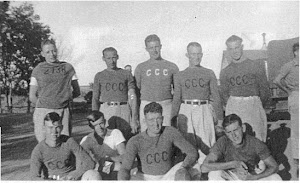

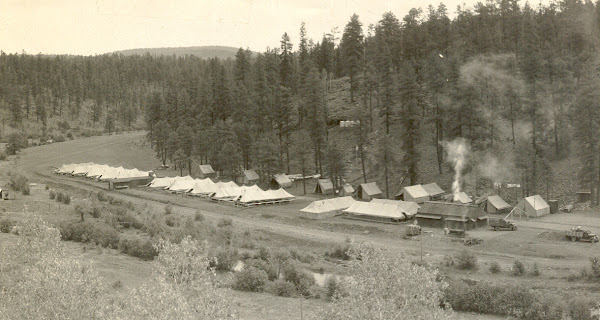

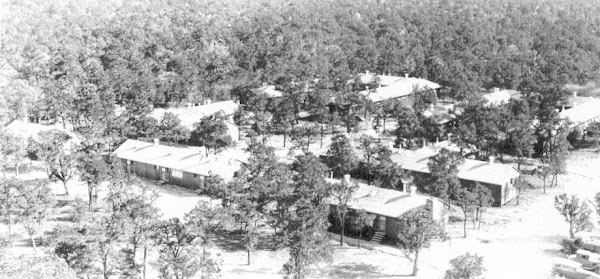



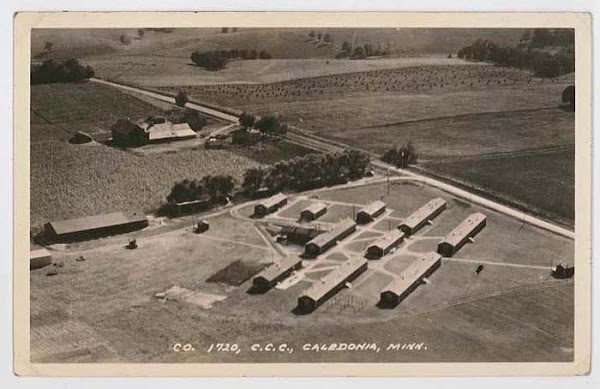
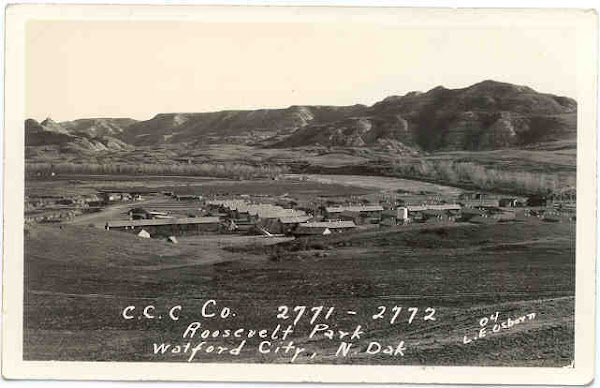
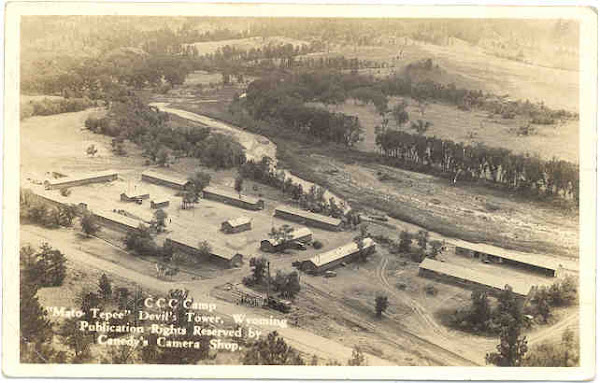
No comments:
Post a Comment